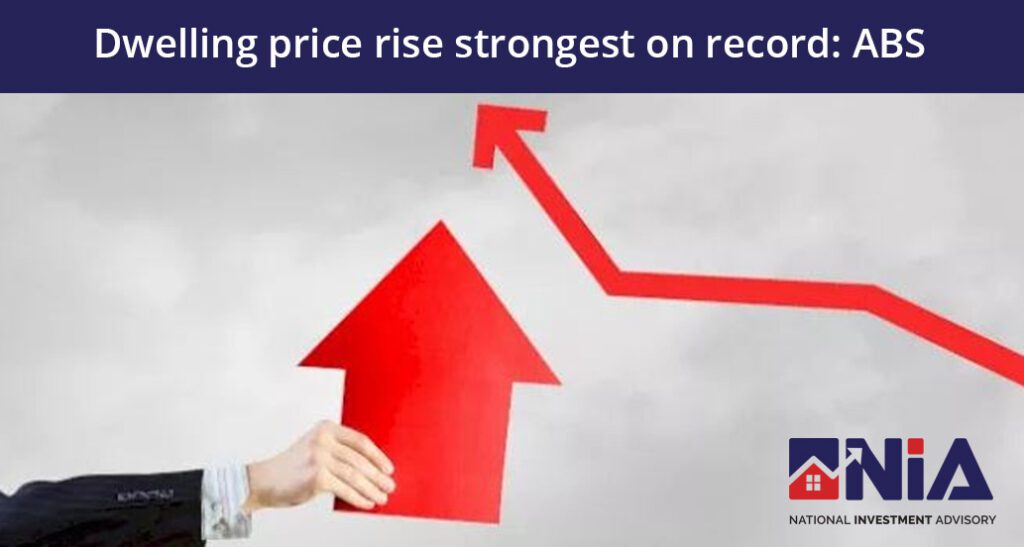Both residential property prices and the total value of residential dwellings recorded the largest quarterly rise on record, according to figures.
The Australian Bureau of Statistics (ABS) has released its June 2021 Residential Property Price Indexes for the eight capital cities, which has revealed that residential property prices rose by 6.7 per cent in the June 2021 quarter.
This has represented the strongest quarterly growth since the index series began in the September 2003 quarter.
All capital cities recorded price rises in the June quarter, while prices rose at rates not seen in many years in all cities except Perth and Darwin.
For instance, Canberra recorded the largest quarterly rise since the series began in September 2003 (up 8.2 per cent), while Sydney had the largest quarterly rise since the June quarter 2015 and the second-largest in the series (up 8.1 per cent).
Meanwhile Hobart (up 6.3 per cent) had the largest quarterly rise since the December 2003 quarter, Melbourne (up 6.1 per cent) had the largest quarterly rise since the December 2009 quarter, Brisbane (up 5.7 per cent) had the largest quarterly rise since the June 2007 quarter, and Adelaide (up 5.3 per cent) had the largest quarterly rise since the December 2007 quarter.
House prices rose by 7.7 per cent across the combined capital cities in the June quarter, while attached dwelling prices rose by 4.3 per cent.
Canberra was the only capital city to experience record quarterly growth in both the house price index (up 8.9 per cent) and the attached dwelling price index (up 6.0 per cent) in the June 2021 quarter.
Dwelling values rise at record levels
Furthermore, the total value of Australia’s 10.7 million residential dwellings also recorded the largest quarterly rise on record, jumping by $596.4 million to $8.9 billion in the June quarter.
Of this total, over $8.5 billion was owned by households.
The value of residential dwellings in NSW in the June quarter was $3.6 billion, around 40 per cent of the total value of dwellings in Australia.
The mean price of residential dwellings in Australia rose by $52,600 to $835,700. NSW recorded the highest mean price in the country ($1.1 million).
Meanwhile the ACT record the second-highest mean price ($891,700), and exceeded Victoria’s mean price for the first time since the March 2015 quarter, albeit only marginally ($891,500).
Commenting on the record property price trends, ABS head of price statistics Michelle Marquardt said: “The continued growth in property prices was occurring at a time of record low interest rates. Persistently low levels of stock on the market were being met with strong demand and properties transacting at an increasingly rapid rate.
“With the exception of Hobart and Darwin, capital cities continued to see house price rises outpace those of attached dwellings such as apartments and units, with price growth for both property types being driven by the upper segments of the market.”
No plans to lift rates to cool market: RBA
The ABS data has been released at the same time as comments made by Reserve Bank of Australia governor Dr Philip Lowe, who reiterated in his address to the Anika Foundation about Delta, the economy and monetary policy that lifting the official cash rate to cool the property market is not on the central bank’s agenda.
While acknowledging that higher interest rates could result in lower house prices (all else being equal), Dr Lowe argued that it would also mean fewer jobs and lower wages growth, and that this is a “poor trade-off in the current circumstances”.
However, Dr Lowe flagged that the sustainability of household borrowing trends has remained an issue, adding that the Council of Financial Regulators has been discussing possible steps if lending standards deteriorate or credit growth accelerates too much.
Moreover, Dr Lowe said that society-wide concerns about rising house prices would not be addressed through hiking interest rates or tightening lending standards.
Instead, he argued: “While monetary policy is contributing to higher housing prices at the moment, the way to address these concerns is through the structural factors that influence the value of the land upon which our dwellings are built.
“The factors include: the design of our taxation and social security systems; planning and zoning restrictions; the type of dwellings that are built; and the nature of our transportation networks. These are all obviously areas outside the domain of monetary policy and the central bank.”
CoreLogic figures recently showed that home values grew at the fastest pace in the past 12 months since 2004, but housing affordability issues had begun to put the brakes on the rate of growth.
(Credit: Malavika Santhebennur)

